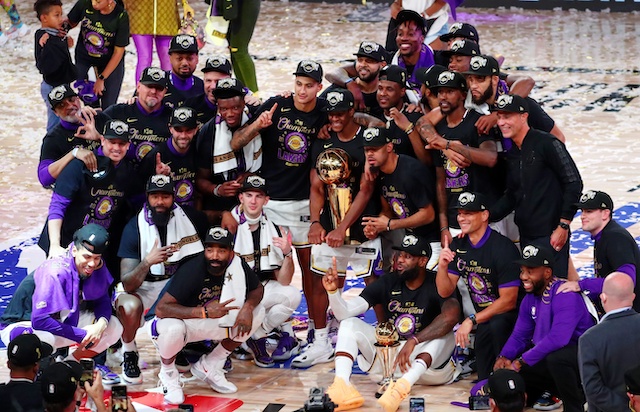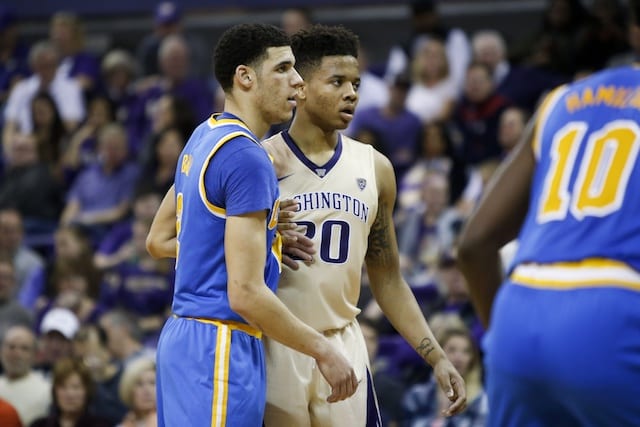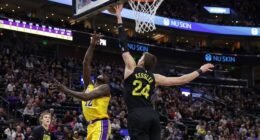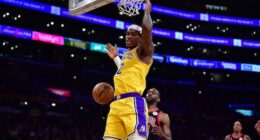There’s a scene in the classic Will Ferrell movie, “Elf”, where Santa’s elves, after toiling away all year to create toys for Christmas, celebrate their success for a scant few seconds before getting right back to work preparing for the next holiday season.
The Los Angeles Lakers, with reports that the 2020-21 NBA season could be starting on December 22, can relate.
After all, they only won the 2020 NBA championship just over a week ago. There would be about 75 days between the deciding Game 6 of the NBA Finals and the start of the 2020-2021 season, giving the Lakers precious little time to rest and recover before they ramp things back up again.
Consider this: before heading into the Disney bubble, Jared Dudley said players needed at least four weeks to ramp up activity after being off for about four months when the league suspended play due to the coronavirus (COVID-19) pandemic.
That ramp-up timeframe would mean the Lakers, who just emerged victorious in the longest NBA season ever, would need to be back into on-court training a mere six weeks after capturing the title.
That simply isn’t enough time to physically or mentally recover from the grind of a long season and the hardships of the bubble and would be a factor that the Lakers front office would have to take into consideration when putting together next season’s roster.
The NBA Draft is scheduled to take place on November 18, and free agency typically follows shortly after. That means teams could realistically be back on the floor before they have their newest additions signed on the dotted line.
This may provide more incentive to keep rosters consistent with last season since theoretically, teams that are already familiar with each other would have an even greater early-season advantage over those incorporating new additions.
Of course, running it back may be all well and fine for teams that were eliminated early in bubble play, like the L.A. Clippers, who have had plenty of time to recover at home. Moreover, teams who were left out of the bubble haven’t played since March, and are certainly anxious to get back on the hardwood with fresh legs.
For the Lakers and Miami Heat, however, a Christmas start may not be so jolly on achy stars, and how they adapt to that challenge will have an impact on their fortunes next season. With the rumor being that the NBA will limit the 2020-21 season to 72 games, the importance of each regular season contest increases.
A slow start due to lingering physical or mental fatigue would do more damage than it would during a typical season.
Load management, as en vogue as it may be, is less realistic in a 72-game season than a regular 82-game grind. LeBron James will be 36 in a few months and Anthony Davis seems to be perpetually banged up. Rajon Rondo and Dwight Howard are both 34, and while they will be free agents, there is interest in bringing them back. Danny Green came out of the bubble with multiple injuries.
Ideally, the Lakers would find odd nights here and there to rest their veterans, and it’s possible they still do so. It’s rational to think, at this point, that a healthy Lakers squad is more important than one that finished first in the Western Conference.
If they put a greater emphasis on rest, and drop to — say middle of the pack in the West — but hit the playoffs healthy, that’s probably a trade off the Lakers would gladly accept.
However, the quick turnaround and fewer games aren’t the only schedule-related issue facing a weary Lakers’ squad.
One of the rumored reasons for the NBA to start the season in December is to finish in time for the Olympics in July (and to perhaps put the 2021-22 season back into a standard October-June calendar), which would provide roughly six months for the upcoming campaign.
A normal, 82-game season, from the first game until the end of the NBA Finals, is about eight months. Dropping 10 games off the schedule doesn’t completely balance out chopping two months off of the season, especially with rumors of a possible midseason tournament or break.
This means that games will come more often, with three or four game weeks being replaced by four or five. Back-to-backs will occur more frequently, which only further underscores how imperative rest will be, but again, it can come with a price in the standings.
On the plus side, Lakers vice president of basketball operations Rob Pelinka and head coach Frank Vogel have proven to have Reed Richards-level flexibility. If there is a way to make things work, they will find it.
That might mean more opportunities for the team’s two-way players and a greater focus on rounding out the roster with usable depth in all 15 spots, though that’s easier said than done.
If anything, the Lakers proved last season that they can adapt to any challenge they are presented with. They will need to continue to do so next season, which could be here before we know it.
Have you subscribed to our YouTube channel? It’s the best way to watch player interviews, exclusive coverage from events, participate in live shows, and more!








